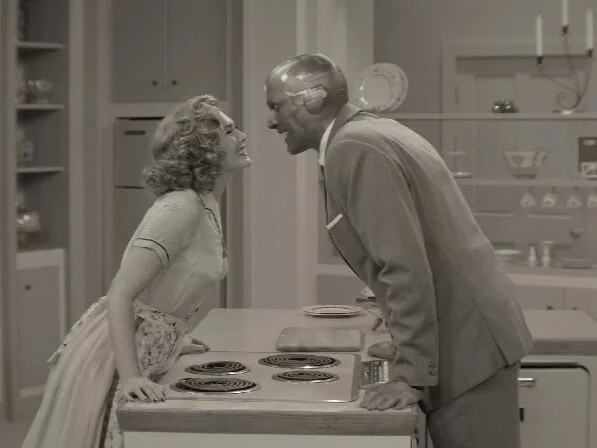Wandavision's Nostalgia Aesthetic
Wandavision represents the entry of the Marvel Cinematic Universe into our living rooms, and features two lesser known heroes from the twenty-movie franchise. Four episodes have been made available on Disney+ so far and I’ve seen all of them. There will be very mild plot spoilers in this post.
Wanda and Vision in black and white, leaning toward each other over a kitchen stove. ©Marvel Studios 2021. All Rights Reserved.
The first three episodes follows a particular format. Each is presented in classic sitcom style from different eras starting with the 50’s, with the pilot doing an homage I Love Lucy; the second episode a bit closer to the early sixties with a Bewitched look; and the third episode (the first full color one) referencing the style of The Brady Bunch.
In each episode we’re introduced to the lives of our main characters as a newlywed couple, as well as their friends and neighbors. Each episode also contains “breaks” from the in-universe reality, intrusions into the narrative where the viewer is given hints that everything is not quite as it seems.
Wanda and Vision in color, dancing in their 70’s style den. ©Marvel Studios 2021. All Rights Reserved.
These breaks are of course the main plot of the show, and everything else around it is intended to acquaint us with the characters, though in a completely artificial context. Thus my experience in watching the first three episodes is 30-ish minutes of classic comedy played straight with a story independent of the main mystery arc, and 3-ish minutes of forward momentum. The hints do escalate in each episode, but I found myself wondering if I really need a 90-minute nostalgia binge to get to the meat of the story.
It also made me wonder who this show is for—or at least who these bits of the show is for. The Marvel movies are known for their wide appeal and their intentionality in marketing to an international audience, and yet this show seems to reward a niche audience that can understand the nostalgic nods that the episodes are making.
S.W.O.R.D. operative Monica Rambeau and FBI agent Jimmy Woo. ©Marvel Studios 2021. All Rights Reserved.
As an avid consumer of pop culture, I get that a lot of things are simply Not Made for Me. I also understand the appeal of nostalgia as an aesthetic, and the resurgence of stories set in time periods when the folks in the writers’ rooms were children. As someone who did not grow up in the United States, I knew about and heard about these shows and am familiar with these references, but I am not emotionally invested in them. Yet with every Stranger Things or every homage to Americana like these Wandavision episodes, I stick around and hope that the aesthetic has a larger purpose than bringing audiences the comforts and pleasant associations with the past.
This is why as much as I was not into the first three episodes, the fourth episode really hooked me. It takes place outside of the established format and is set in the present timeline, featuring characters outside of the sitcom universe we’ve been introduced to. We’re given the context of what the first three episodes are about, and also an assurance from the writers that yes, we picked classic American TV sitcoms for a narrative reason, not just because we personally think it’s cool.
Plot twists, unconventional structures, and niche cultural references are not exactly the MCU’s strong suit, so I had my doubts. I felt like there would be no payoff to my time spent watching sitcom homages that I have no nostalgic ties to. Episode Four changed that, and though it definitely could have come a lot sooner, I’m very happy that it did.


